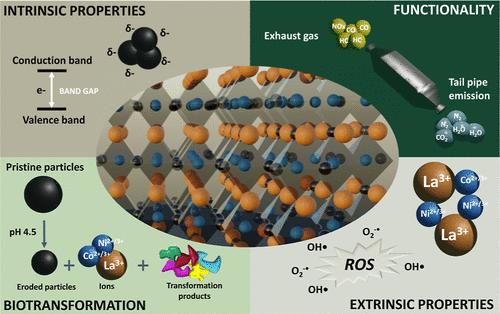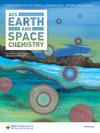Oxide-Perovskites for Automotive Catalysts Biotransform and Induce Multicomponent Clearance and Hazard
IF 2.9
3区 化学
Q2 CHEMISTRY, MULTIDISCIPLINARY
引用次数: 0
Abstract
Oxide-perovskites designed for automotive catalysts contain multiple metal elements whose presence is crucial to achieving the targeted performance. They are highly stable in exhaust operating conditions; however, little is known about their stability under physiological conditions. As some of the metallic components are hazardous to humans and the environment, perovskite benefits in cleaner air must be balanced with risks in a Safe and Sustainable Design (SSbD) approach. New approach methodologies (NAMs), including in chemico and in silico methods, were used for testing hazards and benefits, including catalytic activity and tolerance for temporary excess of oxygen under dynamic driving conditions. The composition and surface properties of six different lanthanum-based oxide-perovskites compromised their stability under lung physiological conditions, influencing the oxidative damage of the particles and the bioacessibility of leaching metals. We found consistent biotransformation of the oxide-perovskite materials at pH 4.5. The leached lanthanum ions, but not other metals, respeciated into lanthanum phosphate nanoparticles, which increased the overall oxidative damage in additive synergy. The NAM results in the presented SSbD approach were challenged by in vivo studies in rats and mice, which confirmed multicomponent clearance from lungs into urine and supported the comparative ranking of effects against well-characterized spinel materials. Among the perovskites, the version with reduced nickel content and doped with palladium offered the best SSbD balance, despite not improving the conventional benchmark catalytic performance and related sustainability benefits. Redesign by industry may be necessary to better fulfill all SSbD dimensions.

用于汽车催化剂的氧化物-超微晶石 生物转化和诱导多组分清除与危害
设计用于汽车催化剂的氧化过氧化物包含多种金属元素,这些元素的存在对实现目标性能至关重要。它们在排气操作条件下非常稳定;然而,人们对它们在生理条件下的稳定性知之甚少。由于其中一些金属成分对人体和环境有害,因此在采用安全和可持续设计(SSbD)方法时,必须平衡包晶石在清洁空气方面的优势与风险。新方法(NAM)包括化学和硅学方法,用于测试危害和益处,包括催化活性和在动态驱动条件下对暂时过量氧气的耐受性。六种不同的镧基氧化物-超微晶石的组成和表面特性损害了它们在肺部生理条件下的稳定性,影响了颗粒的氧化损伤和浸出金属的生物可吸收性。我们发现氧化物-超微晶石材料在 pH 值为 4.5 时会发生一致的生物转化。浸出的镧离子(而非其他金属)重新生成了磷酸镧纳米颗粒,这增加了整体氧化损伤的叠加协同作用。在大鼠和小鼠体内进行的研究对所提出的 SSbD 方法中的 NAM 结果提出了质疑,这些研究证实了多组分从肺部进入尿液的清除率,并支持与特征明确的尖晶石材料进行效应比较排序。在这些包晶石中,镍含量降低并掺杂钯的版本提供了最佳的 SSbD 平衡,尽管没有提高传统基准催化性能和相关的可持续发展效益。工业界可能需要重新设计,以更好地满足 SSbD 的所有要求。
本文章由计算机程序翻译,如有差异,请以英文原文为准。
求助全文
约1分钟内获得全文
求助全文
来源期刊

ACS Earth and Space Chemistry
Earth and Planetary Sciences-Geochemistry and Petrology
CiteScore
5.30
自引率
11.80%
发文量
249
期刊介绍:
The scope of ACS Earth and Space Chemistry includes the application of analytical, experimental and theoretical chemistry to investigate research questions relevant to the Earth and Space. The journal encompasses the highly interdisciplinary nature of research in this area, while emphasizing chemistry and chemical research tools as the unifying theme. The journal publishes broadly in the domains of high- and low-temperature geochemistry, atmospheric chemistry, marine chemistry, planetary chemistry, astrochemistry, and analytical geochemistry. ACS Earth and Space Chemistry publishes Articles, Letters, Reviews, and Features to provide flexible formats to readily communicate all aspects of research in these fields.
 求助内容:
求助内容: 应助结果提醒方式:
应助结果提醒方式:


